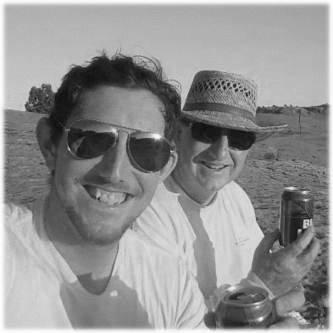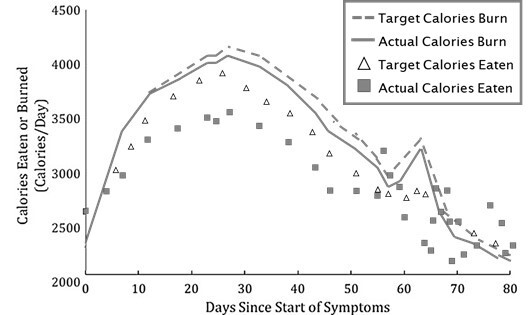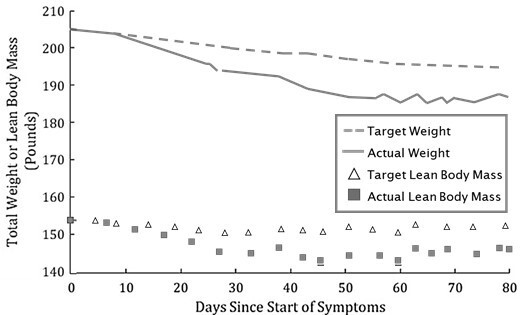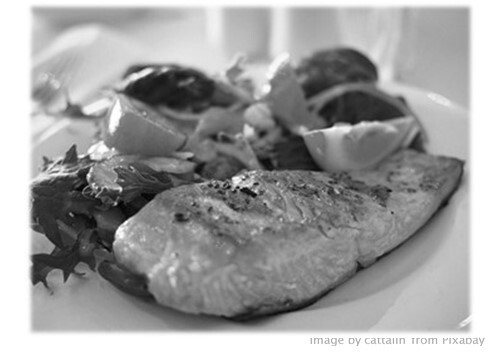Chapter 9. Eating for Recovery with a High Calorie Diet
James Croughan
I am the elder son of Matt and Kathy Croughan. For many years now, Matt has taken me and my brother Jess on epic mountain bike rides at high altitude. Including sightseeing, the rides often last all day, with up to 6 hours of actual riding. To enjoy such rides, it is critical to eat enough calories, often 1,000-3,000 kcals (calories) more than I would normally consume. My brother and I quickly learned to pack extra snacks or small meals in case Matt underestimated the time and distance (an ongoing problem with him).
Now, as an avid weightlifter for the previous ten years, I have learned to closely track my calories and ensure that I get plenty of nutrients whenever my body needs them, regardless of appetite. This has resulted in nearly fifty pounds of lean muscle gain since I started. As such, Matt recognizes my expertise in high calorie, healthy diets and has asked me to write this chapter.
I am happy to say that he also now listens to my advice when planning the food needed for our epic rides.
COVID-19 and Calories are Intimately Related
As mentioned in Chapter 6, one of the best ways to prepare your body to handle COVID-19 is to eat an appropriate amount of healthy, highly nutritious food. This mindset does not change when dealing with a current COVID-19 infection.
But special care has to be taken to ensure the correct amount of calories and nutrients are provided to the body during this demanding situation. While not as healthy as fruits and vegetables, supplemental high-calorie foods will be necessary in addressing the calorie shortfall during an active infection.
The symptoms of COVID-19 can require vast amounts of energy to manage - a fever will require extra energy to sustain the elevated temperature, and a consistent cough requires significant effort from the core muscles. This manifests as another very common symptom of COVID, fatigue.
This is not personal conjecture either as not only is there evidence that most illnesses require increased energy demands (Richardson, 2020). COVID-19 also specifically activates especially high caloric requirements (Yu, 2020).
Sufficient caloric intake may help to alleviate some of these symptoms by providing the body with the fuel it needs to fight off the virus. Additionally, a highly nutritious diet will also enable the body to heal to its full potential.
The virus and its many potential complications can cause significant damage to many vital organs and muscles around the body. To fully recover, the body needs to repair this damage, which requires vast amounts of calories, nutrients, and sleep. This chapter is meant to serve as a guide to help you or your caretaker design a high-calorie diet while sick, without providing specific recipes.
The Need for a High Calorie Diet
Matt’s severe case of COVID-19 provides an excellent example of the need for a high calorie diet. As discussed in Chapters 2 and 11, he suffered from bad fatigue and substantial weight loss.
Matt, being the scientist he is, was already tracking his daily calorie burn through his Garmin Vivosmart 4. Ultimately though, he was too fatigued to respond to the data or use it to help recover. Later on, during his recovery, he did calibrate the device and apply a correction factor to the results, as explained in Appendix 7.
When his symptoms were severe, he then noticed his weight loss and tried to eat as much as possible, but did not know if he was eating enough, nor the best method to introduce far more calories into his diet. His fatigue and weight loss continued at a severe level for three weeks.
Finally, he then went on oxygen. His fatigue then improved a bit but did not fully recover until he followed my advice: eat more. Hopefully he now knows to follow more of my advice in the future.
The next two charts graphically illustrate what happened with Matt. His estimated calorie burn and calories eaten are shown in the top chart.
He ate when he was hungry, but a severe case of COVID-19 makes your appetite unreliable. Confirmed by the data collected and calculated in the figures below, this meant he was consistently under eating by over 600 calories a day, for weeks on end!
In both the actual and target sets of lines in the figure, the amount of calories burned is more than the calories eaten.
The second chart below shows the effect of this. His total weight (top solid line of figure below) dropped by 19 pounds over two months! Furthermore, as it turns out, his lean body mass dropped by 10 pounds, more than half of his total weight loss.
The dashed line and the triangles are an estimate of what would have happened had he ate about 90% of the target amounts recommended in this chapter. This is based upon protocols that will be thoroughly explained below.
He would have still eaten less than his calorie burn, but only by about 300 calories per day. This would have caused him to lose 10 pounds of total weight, but only 2 pounds of lean body mass, a major improvement! This would likely have also dramatically reduced the fatigue he experienced, improved his mood, and hastened his recovery.
What is a High Calorie Diet?
A high calorie diet in the context of this book refers to a diet in which the daily calorie intake exceeds 500 calories beyond the baseline calorie burn for an individual. The baseline calorie burn is simply the basal metabolic rate (B.M.R.) and any calories burned due to sedentary daily activities, not including any purposeful exercise or physical labor.
This number depends on several factors and represents how many calories your body needs just to operate vital organs and stay warm. An American adult male’s baseline calorie burn is typically around 2,000 calories per day.
That means that a diet of at least 2,500 calories per day would qualify as a high calorie diet. Diets like these are common among those that are healing from an injury, growing, or intentionally gaining weight.
Estimating Your Calorie Needs While Sick
The first step in determining how many calories you should eat while sick is to determine your B.M.R. Many different websites offer free calculators that will determine this number for you. The next step is to multiply the B.M.R. by a multiplier based on how sick you feel using the table below.
These numbers were calculated using my Matt’s data and they accurately account for his weight loss. Take this calculated number and add 300 to get the final target caloric intake.
The goal should be to eat this many calories per day until the severity of symptoms improve, at which point it should be recalculated. Weight loss of 1 to 2 pounds per week may still occur at these calorie consumption levels.
|
Severity of Symptoms
|
Example of Symptoms
|
Multiplier
|
|
Long Term Recovery
|
Elevated heart rate as lungs heal
|
1.25
|
|
Very Mild
|
Mild fatigue and occasional cough
|
1.50
|
|
Mild
|
Chills, mild fatigue and/or cough
|
1.70
|
|
Moderate
|
Fever, fatigue, frequent cough.
|
2.00
|
|
Severe
|
Fever, bad fatigue, frequent cough with hacking, chest spasms, often also hypoxia
|
2.40
|
Case Study: Matt’s COVID-19 Calorie Story
As an example, we will walk through the process for Matt, a 59-year old male who is 5 feet 9 inches tall and weighed 205 pounds at the point of moderate symptom onset (multiplier of 2.0). His target intake was then as follows:
Basal Metabolic Rate: 1,735 calories per day
Multiplier: 2.0
Target caloric intake = (1,735 × 2.0) + 300 = 3,770 calories per day
He failed to eat at this target calorie level and lost weight quickly while feeling more fatigue. By two weeks, his symptoms had worsened into the severe category (multiplier of 2.4). His target intake was then as follows:
Basal Metabolic Rate: 1,726 calories per day
Multiplier: 2.4
Target caloric intake = (1,726 × 2.4) + 300 = 4,442 calories per day
He again failed to eat at this target calorie level. His condition
continued to worsen. Ultimately, due to worsening hypoxia, he ended up in the hospital. For the purposes of calorie analysis, this falls into the severe category, with a multiplier of 2.4.
Although his new oxygen therapy helped dramatically, he still continued to not eat enough calories and he lost even more weight.
After two more agonizing weeks, Matt’s symptoms began to subside into the mild-to-moderate categories, with an average multiplier of about 1.8 (mostly mild). His daily calorie intake during this period was then:
Basal Metabolic Rate: 1,722 calories per day
Multiplier: 1.8
Target caloric intake = (1,722 × 1.8) + 300 = 3,400 calories per day
After eight weeks, his symptoms had further subsided into the mild to very mild category. His appetite improved and he finally
increased his calorie intake to match his calorie burn at around 2,900 to 3,200 calories per day. His weight stabilized. When he did not eat enough, he felt some fatigue that evening and/or the next day, and purposefully ate more the next day.
He continued to improve into the long-term recovery category, with a target intake of around 2,450 calories per day without exercise. He started an exercise program, gradually increasing from mild to moderate to vigorous. Thus, he sometimes ate up to 3,000 calories, as needed to avoid fatigue and weight loss, as he exercised and recovered his lean muscle mass.
The recommended food intake during his main three weeks of the illness averaged around 4,000 calories per day, far higher than what he normally eats. This required him to eat drastically more than his appetite indicated.
To do this, he needed to drastically adjust his diet based upon the scheme described in this chapter. He did not understand the severity of the situation, he did not adjust his appetite, and then paid the price in longer recovery and harsher symptoms. Hopefully, after reading this chapter, you will not make the same mistake.
Highly Active Individuals
Note that a huge adjustment in diet may not be necessary for highly active individuals, such as distance runners. These individuals may have normal caloric intakes in the range of 3,000-4,000 calories per day.
Individuals who fall in that category should first estimate their existing calorie intake. If this estimate is within 500 calories of the suggested level, then they should scale up the quantities as necessary instead of adjusting the type of food eaten. This will be easier from a planning standpoint, as athletic diets typically already have high nutrient density.
How to adjust your diet
There are many ways in which to increase your daily calorie and nutrient intake. The healthiest way to do so is with added healthy fats, proteins, and fruits. Refined carbs (such as white bread, white rice, and sugar) are calorie dense, but generally do not contain many nutrients. Raw vegetables, on the other hand, are nutrient dense, but lack calories. This makes both categories poor choices because the goal is to increase both calories and nutrients, but stomach space is limited.
That being said, vegetables can still serve as delivery vehicles for other foods, such as healthier spreads like hummus. They can also help with the digestive problems often associated with these dense foods.
There are many good meat choices available. Some particularly high calorie and nutrient dense meats are traditional steaks, 10 or 20% fat ground beef, any lamb, chicken thighs, and ham. Bacon is very, very high calorie and delicious, but it is very high in salt and low in nutrients compared to the other meats.
Salmon is far and away the best choice among the fish options, with about half again more calories per serving than other common fish.
All of these can be prepared with olive oil, which is a great way to add some healthy fat and flavor. Eggs and full fat dairy products also supply a large amount of fat, protein, and nutrients.
High fat nut butters and spreads are one of the easiest ways to add supplemental calories and nutrients. Hummus, peanut butter, guacamole, and many other simple spreads pack a lot of nutrition in a very small space. A single jar of peanut butter can have over 6,000 calories in it, and plenty of nutrients to boot! Incorporate these into a favorite recipe or pair with bananas or other fruits and vegetables for maximum impact and flavor.
The symptoms of COVID-19 can reduce how much food can be consumed at any given time without triggering nausea, making frequent snacking a necessity. Fruits, meal replacement bars, meal replacement shakes, and nut bars are great choices that require zero preparation. So, even a very sick person can have them without the help of a caretaker.
Try and avoid highly processed foods for the primary snacks, as they lack nutrients. Sugary foods like candy and desserts should only be consumed when the stomach is already mostly full. This prevents blood sugar spikes and crashes, as these will be particularly harsh when combined with COVID-19 symptoms. It may also help to have four or five meals a day instead of three if nausea is a frequent problem when eating this much.
In the previous example, Matt had a target of about 4,500 calories per day when his symptoms were the most severe. He gets nausea if he eats too much at once, so he spreads his food out over four meals and five snacks a day to help with that.
There are a variety of online tools and apps that can help you estimate the calorie contents of the actual amount of food that you
plan to eat. A typical diet for him may look like the following:
|
Sequence
|
Food
|
Calories
|
|
Meal 1
|
3 eggs, 1 slice of ham, banana with peanut butter
|
750
|
|
Snack 1
|
Apple and some cherries
|
150
|
|
Meal 2
|
Fully loaded burger: two 20% fat patties cooked in olive oil. Topped with two strips of bacon, cheese, an egg, guacamole, and whole grain bun
|
980
|
|
Snack 2
|
Nutrition bar and some milk
|
400
|
|
Meal 3
|
2 cups premade chicken noodle soup with 2 added chicken thighs
|
770
|
|
Snack 3
|
Broccoli dipped in hummus and a peach
|
200
|
|
Meal 4
|
6 oz Steak and cheesy mashed potatoes
|
780
|
|
Dessert
|
Brownie
|
130
|
|
Snack 5
|
Almonds and a banana
|
260
|
|
Total
|
4,420
|
|
|
|
If you want to avoid this level of detail, some good approximations are the following:
|
Meal
|
Calories
|
|
Each half-plate of high calorie food (like the foods described above)
|
750
|
|
Each half-plate of normal calorie food
|
500
|
|
Each half-plate of low-calorie food
|
250
|
|
Most prepackaged snacks
|
200
|
|
Homemade snacks (like a small sandwich)
|
300
|
|
Each half plate of vegetables
|
50
|
|
Heaping spoonful of peanut butter
|
200
|
Another important thing to remember is that a significant amount of fruit and vegetables on your plate will make that plate
count as a half-plate of normal calorie food. But as your mom always told you, a diet with more fruit and veggies are never a bad thing.
Using these approximations, the example diet above would be:
3 half-plates of high calorie food (meals 2,3,4)
1 half-plate of normal calorie food (meal 1)
4 homemade snacks, (snacks 1,2,3 and late-night snack)
1 prepackaged snack, (brownie)
1 spoon of peanut butter (with meal 1)
This adds to 4,350 calories, which is quite close to the original estimation of 4,420 calories. These target calorie numbers are approximations, so this level of accuracy will work.
Closing Thoughts
If you get sick, your body will be at war with COVID-19 and it will need far more energy than it normally does. You must drastically increase your calorie intake during this time, otherwise your body will not have the resources it needs. There are many ways to increase your calorie intake, even if you do not feel like eating much.
Incorporate healthy spreads with vegetables. Enjoy a nice steak. Indulge in the occasional
sweet dessert. It may seem a bit daunting to try and plan for eating all this food without just substituting for cheap alternatives, like ice cream. But we hope that, with the tools we provided in this chapters, you will have all the information you need to start.
If in doubt, eat a bit more.






